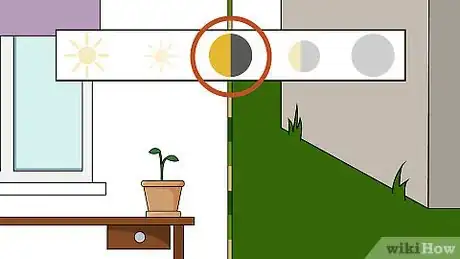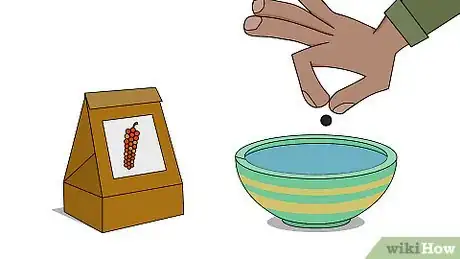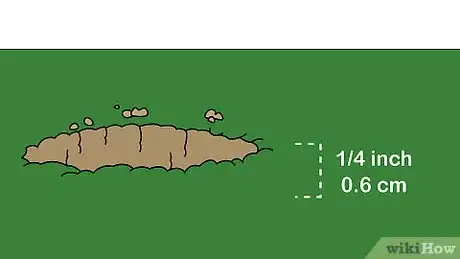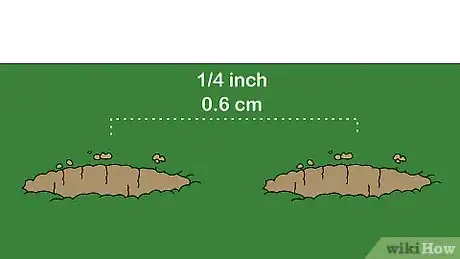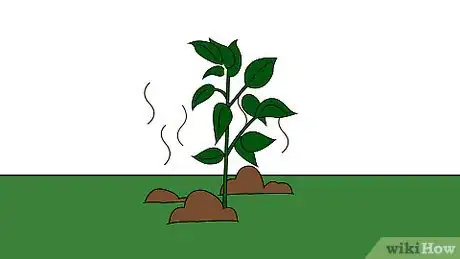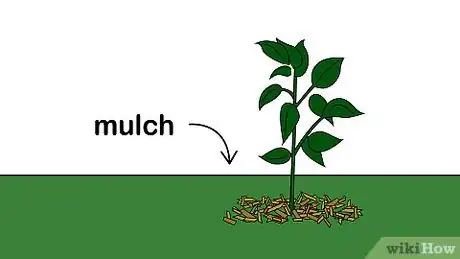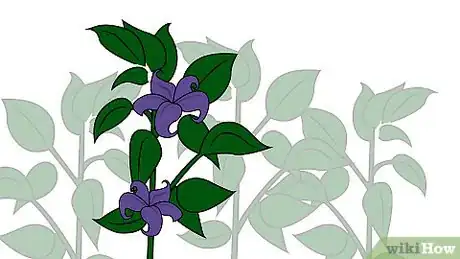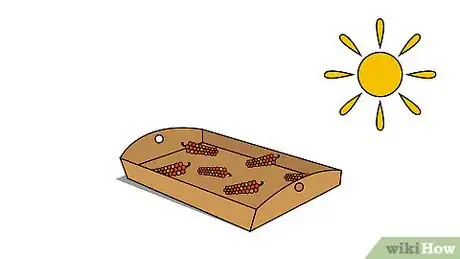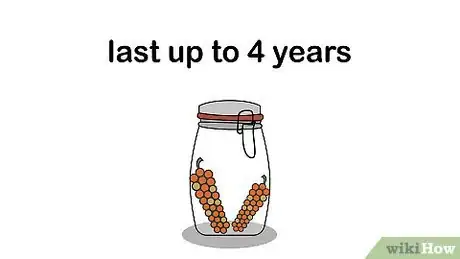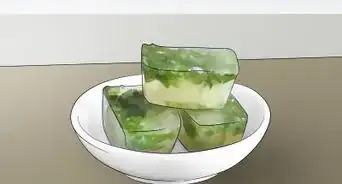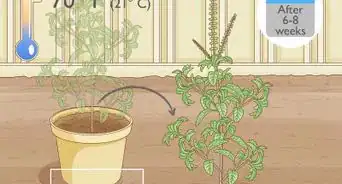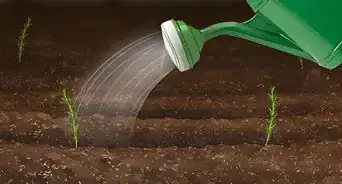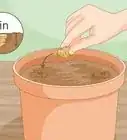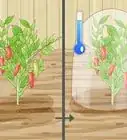This article was co-authored by Maggie Moran. Maggie Moran is a Professional Gardener in Pennsylvania.
There are 11 references cited in this article, which can be found at the bottom of the page.
This article has been viewed 126,281 times.
Black pepper is a flowering vine that is best known for its fragrant, spicy peppercorn berries. Although the plant grows best in tropical climates, it can adapt to drier or cooler climates. As long as a peppercorn plant is grown in a warm temperature, with partial shade and a place for its vines to spread, it can thrive. Take care when planting, growing, and harvesting your plant so it can produce the healthiest peppercorn berries possible.
Steps
Planting Black Pepper
-
1Choose a spot with temperatures between 75–85 °F (24–29 °C). Black pepper is native to tropical climates and thrives when the temperature is between 75–85 °F (24–29 °C). If temperatures fall to 60 °F (16 °C), the plant begins to die.[1]
- Black pepper can be grown indoors or inside a greenhouse if you live in a colder climate.
- Growing zones 10 and 11 are ideal for black pepper. If you're not sure what growing zone you live in, you can look it up online.
-
2Find an area with partial shade to plant your black pepper. Black pepper needs between 6 to 8 hours of indirect sunlight per day. Choose a place in your garden that receives mixed shade and sunlight throughout the day, or place your plant near a window that receives periodic sunlight.
- If you live in a cloudy climate, purchase a sunlamp for your plant.[2]
Advertisement -
3Install a trellis into the ground where you plant your black pepper. As black pepper plants grow, its vines can reach up to 15 feet (4.6 m) long. A trellis can keep your plant's vines from getting trampled. Dig two post holes for the trellis at least 3 inches (7.6 cm) away from the plant and press the trellis legs into the hole firmly. Follow the trellis instructions to secure the trellis in the ground so it can support the black pepper vines.[3]
- Pepper plants can also make great hanging plants during their first year when they're young and their vines are not as long.[4]
-
4Plant your black pepper plant in well-draining soil. Black pepper thrives best in rich soil that drains easily. To test whether your soil is well-draining, dig a small hole, 12–18 inches (30–46 cm) across and 12–18 inches (30–46 cm) deep, in your garden and fill it with water. Count how many seconds it takes for the hole to empty. If the hole takes between 5 to 15 minutes to empty, you have well-draining soil.[5]
- Use a soil pH tester kit to make sure the soil you're using has a pH between 5.5 and 7.
- Add compost, sand, silt, peat, or loam to make soil well-draining.[6]
-
5Soak your black pepper seeds for 24 hours before planting. Hard, dry seeds will be less responsive to the soil's nutrients. Fill a small bowl with water and let your pepper seeds soak for at least a day prior to planting.[7]
- Lukewarm or room temperature water is ideal for soaking your seeds. The type of water doesn't matter—tap water is fine.
- If you prefer to plant cuttings in your garden, you do not need to let them soak beforehand.
-
6Dig a 1⁄4 inch (0.64 cm) deep hole in your soil. If you are planting seeds, they should rest about 1⁄4 inch (0.64 cm) below the surface. Place your cutting or seed in the hole. Cover your seed or the bottom of your cuttings with the soil so it can receive the nutrients it needs to grow.
-
7Plant your black pepper seeds or cuttings 1–2 inches (2.5–5.1 cm) apart. If you are planting multiple black pepper seeds or cuttings, give them 1–2 inches (2.5–5.1 cm) of space to grow. After you plant your seeds or cuttings in the ground, moisten them with a water-filled spray bottle.[8]
-
8Start your black pepper seeds indoors if you live in a cold climate. Fill a tray or container with soil and plant your black pepper seeds 1⁄4 inch (0.64 cm) below the surface. Spread the seeds apart so they're 3 inches (7.6 cm) away from each other. Water the seeds immediately after planting them. Keep the seeds indoors for about 30 days before transferring them outside.
- Keep the soil the seeds are in warm and moist during the 30 days the seeds are inside. It may help to place the seeds next to a heat source.
Watering and Caring for Your Plant
-
1Water your plant 2 to 3 times per week. Black pepper plants need damp soil and grow best when watered several times a week. In hotter climates, you may need to water your plant more often. Stick a finger in the soil to check its moisture level; if the soil feels dry or hot, water your plant.[9]
- Warm or cool water is preferred to cold water, as black pepper plants are sensitive to cold temperatures.
-
2Fertilize the pepper plant every 2 weeks. Applying a fertilizer twice a month can keep your plant healthy and strong. Purchase an organic fertilizer from the store or make your own compost to give your plant supplemental nutrients. Spread the fertilizer around and in the soil (by tiller or by hand) so your pepper plant can absorb the nutrients.
- How much fertilizer you use depends on its strength. Read the instructions as you use your fertilizer to determine how much your black pepper plant needs.
- Black pepper plants respond particularly well to liquid fertilizers.
-
3Mulch your plant twice per year. Pepper plants have a shallow root system and soak in organic nutrients well. Mulching your plant every 6 to 8 months can keep the soil damp and reduce temperature fluctuations during the day and night.[10]
- Organic mulches made of grass clippings, leaves, or manures work well with pepper plants.
- Plant your mulch at least 2–4 inches (5.1–10.2 cm) below the ground, so your plant's roots can more fully absorb it.
-
4Spray insecticide on the plants to get rid of mealybugs or lace bugs. Lace bugs have black, rectangular bodies with horn-like protrusions on its shoulders. Mealybugs are white and round with many small legs protruding from the sides of its body. If you notice either bugs on your plants, spray your plants with a non-toxic insecticide, as directed on the product's instructions.[11]
- Lace bug damage symptoms: brown or black discoloration, wilting, or graying peppercorn berries.
- Mealybug damage symptoms: poor or stunted plant development, damaged peppercorn berries, and gray mold.
-
5Avoid overwatering your plant to prevent wilting. Quick and slow wilt are the most common pepper plant diseases, and they can progress to root rot when untreated. Dip your finger into the soil whenever you water your plant. If the soil feels drenched or water pools into the hole your finger leaves, do not water your plant.
- Watch for signs of overwatering, like yellow or brown leaves, wilted vines, moldy roots, or blisters or lesions on the plant.
Harvesting the Peppercorns
-
1Wait 2 to 3 years to harvest your pepper plant. Black pepper usually does not produce fruit until several years after planting. When your plant is fully-grown, it will grow flowers in the spring and summer and form peppercorn berry clusters.
- Buy an adult pepper plant if you want to harvest your pepper plant sooner.
-
2Harvest the peppercorn berries when they turn red. When peppercorns are ready to pick, they will turn from green to light red. Pluck the berries from the plant one at a time, working carefully to avoid plucking unripe berries. Bring a container with you as you harvest your pepper plant, to put the berries inside.[12]
- Not all peppercorn berries will mature at the same time. You may need to harvest your plant several times in a single season.
-
3Dry your peppercorns in the sun for 7 to 9 days. Spread your peppercorns out on a flat surface, like a baking pan, where they can receive direct sunlight. Keep your peppercorns drying outside until the outer skin shrinks, turns black, and develops a hard and dry texture.[13]
-
4Grind the peppercorns to make black pepper. Use a mortar and pestle or pepper grinder to make a delicious, fresh spice from your garden. If you are not a fan of ground pepper, you can also use whole peppercorns to flavor soups or sauces or crushed peppercorn as a spice on meats.
-
5Store peppercorns in a dry, cool place for 4 years. As long as peppercorns are stored in an airtight container, they can last for up to 4 years. After 4 years, your peppercorns will still be safe to eat, but they may lose their flavor.[14]
- To test whether peppercorn is still potent, crush one of the berries with your finger and smell it. If the aroma is weak, it has probably lost its flavor.
Expert Q&A
Did you know you can get expert answers for this article?
Unlock expert answers by supporting wikiHow
-
QuestionIs pepper grown in the US?
 Maggie MoranMaggie Moran is a Professional Gardener in Pennsylvania.
Maggie MoranMaggie Moran is a Professional Gardener in Pennsylvania.
Home & Garden Specialist
-
QuestionHow long does it take to grow a pepper plant from seed?
 Maggie MoranMaggie Moran is a Professional Gardener in Pennsylvania.
Maggie MoranMaggie Moran is a Professional Gardener in Pennsylvania.
Home & Garden Specialist
-
QuestionWhat are the benefits of black pepper?
 Maggie MoranMaggie Moran is a Professional Gardener in Pennsylvania.
Maggie MoranMaggie Moran is a Professional Gardener in Pennsylvania.
Home & Garden Specialist
References
- ↑ http://balconygardenweb.com/how-to-grow-black-pepper-plant-growing-peppercorn/
- ↑ http://www.bhg.com/gardening/houseplants/care/indoor-plant-lights/
- ↑ http://www.nda.agric.za/docs/Infopaks/pepper.htm
- ↑ http://www.missouribotanicalgarden.org/PlantFinder/PlantFinderDetails.aspx?kempercode=d276
- ↑ https://www.treepeople.org/sites/default/files/pdf/resources/How-to%20Test%20Soil%20Drainage.pdf
- ↑ https://www.rhs.org.uk/advice/profile?pid=179
- ↑ http://www.agricultureinzambia.com/how-to-grow-black-pepper/
- ↑ http://balconygardenweb.com/how-to-grow-black-pepper-plant-growing-peppercorn/
- ↑ http://thepepperseed.com/growing-peppers/how-and-when-to-water-pepper-plants/
- ↑ http://www.nda.agric.za/docs/Infopaks/pepper.htm
- ↑ https://plantvillage.org/topics/black-pepper/infos
- ↑ http://balconygardenweb.com/how-to-grow-black-pepper-plant-growing-peppercorn/
- ↑ https://www.indiaagronet.com/horticulture/CONTENTS/black_pepper.htm
- ↑ http://www.stilltasty.com/fooditems/index/17956
About This Article
To grow black pepper, first purchase some black pepper seeds and soak them in water for 24 hours. Black pepper needs temperatures between 75 and 85° F (24 and 29° C) to grow, but you can grow it indoors or in a greenhouse if you live in a cooler climate. Plant the seeds in ¼-inch (0.6-cm) deep holes 1 inch (2 ½ cm) apart from each other in a shady spot outdoors or in a pot if you're growing them inside. Then, install a trellis in the soil so the black pepper has something to vine on. Water your plant 2-3 times per week so the soil doesn’t dry out, and feed it a 10-10-10 fertilizer diluted in water every 1-2 weeks, except during the winter. After 2-3 years, your black pepper plant will start producing peppercorn berries that you can harvest and turn into ground black pepper. For more tips from our Horticulturist reviewer, including how to harvest your peppercorns when they're ready and use the peppercorns to make black pepper, read on!

